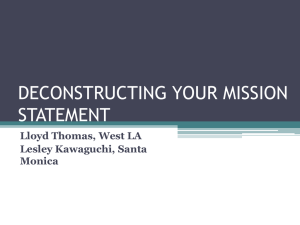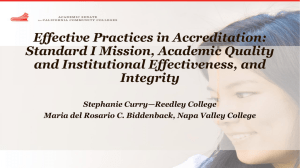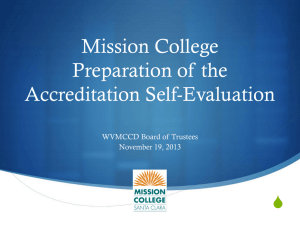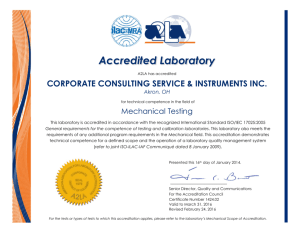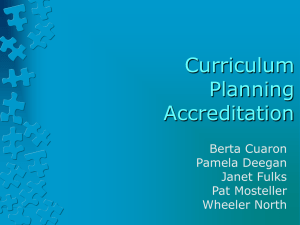The New Standards
advertisement
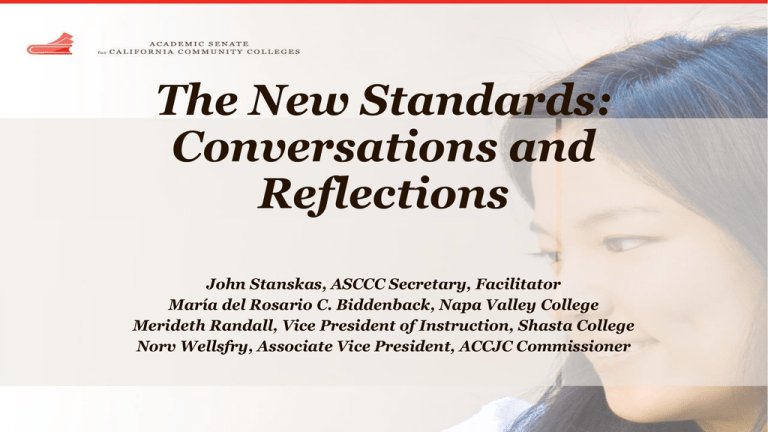
The New Standards: Conversations and Reflections John Stanskas, ASCCC Secretary, Facilitator María del Rosario C. Biddenback, Napa Valley College Merideth Randall, Vice President of Instruction, Shasta College Norv Wellsfry, Associate Vice President, ACCJC Commissioner • As more and more colleges are held accountable for the newly revised standards, dialog and conversation among community college faculty and staff is essential to help colleges interpret the new standards and take actions now to address them. In this breakout, faculty and staff from colleges such as Napa Valley College and the Los Angeles Community College District will discuss their experiences with the new standards to date. ASCCC-Accreditation Institute February 19-20, 2016 San Diego, CA Outcomes Attendees: Will discuss the newly revised 2014 ACCJC standards with faculty and staff from colleges that have been visited or will soon be visited by a site team to learn tips and advice for their own district. ASCCC-Accreditation Institute February 19-20, 2016 San Diego, CA Evolving Federal Focus 60’s – Resources 70’s and 80’s – Process (Program Review and Planning) 90’s – SPREs – focus on data 00’s – Sec Spelling – Student outcomes as measure of quality 08 – HEA – Student Achievement Standards, 2 year rule enforcement, increasing focus on compliance with Regulations and Rule Making 44 Timeline for Changes to Standards and Practices • 2011 – ACCJC announces review of Standards, appoints Committee of Commissioners and staff– Commissioners Frank Gornick and Mike Rota co-chair • 2012 – ACCJC conducts hearings, solicits written input, and more than 300 people comment on what needs to be changed in Standards – Commissioner Committee discusses and drafts standards language – Staff writers draft, redraft, and add federal regulatory requirements • ACCJC appoints work groups including staff from member colleges to help define GE requirements, and SLO language 5 Timeline for Changes to Standards and Practices – 2 • 2013-14 ACCJC drafts new Accreditation Standards and vets them, holds hearings, then adjusts as per input from field • June 2014, ACCJC adopts new Accreditation Standards • 2014-15, ACCJC adopts new practices and policy language • ACCJC still responsive to comments from members 6 Summary of Changes to the Standards • • • • • • • 7 Simplified format Reduced redundancies and clarified language Standards linked to related Eligibility Requirements New emphasis on outcomes (Student Achievement) Improvement throughout the institution New Standard on Institutional Integrity (I.C) Incorporated federal regulatory requirements New Practices - 1 • Comprehensive ISER eliminates section on response to prior team Recommendations, takes “clean Slate” approach to new Standards • ISER includes a Quality Focus Essay • Actionable Improvements Plans (coming from the institution’s comprehensive self evaluation) Incorporated into existing institutional planning processes; Improvements made are reported in Midterm 8 Quality Focus Essay • Essay (QFE) – Two or three “quality improvement projects” – Potential for Sustainable Improvement of Student Outcomes academic quality, institutional effectiveness, and excellence – Realistic – based on Assessment data analysis in ISER – QFE topics selected during self-evaluation process “Accreditation Asks for a Focus beyond Compliance to Quality Improvement” ACCJC Newsletter – Spring/Summer 2015 9 New Practices - 2 • ISER must include longitudinal data presentation and analyses from annual report data colleges prepare each year for ACCJC. • Institutions must include institution-set standards for student achievement (federal requirement) and college’s own analysis of what the data means, along with plans to try to improve student outcomes • 7-Year Cycle for Reaffirmation of Accreditation 10 New Practices - 3 • Seven-Year Cycle with Midterm in year 4 • Quality Focus Essay • Actionable Improvements Plans (coming from the institution’s comprehensive self evaluation) • Incorporated into existing institutional planning processes; • Improvements made should be noted Continued 11 New Practices – 4 • Individual College self Monitoring and Follow-Up of Data Indicators in Annual Reports (required by USDE) • ACCJC provides the templates in the Annual Report – Component of Midterm • Additional data elements for Institution-Set Standards (ISS) should be described 12 New Practices – 5 • Types of recommendations: • • Compliance Improvement Separated in action letters Standards are met or not met (no “partial” compliance) Non-compliance resolved in two years; improvement efforts continue throughout the 7-year cycle 13 Changes to Policy • Policy on Commission Actions on Institutions √ Reaffirmation for limited term (new option) √ Requirement of compliance within two years (federal two-year rule) √ Changed timeline for Commission follow-up (generally 18 months) √ Common definitions for sanctions across all all regional accreditors 14 Changes to Trainings • Spring 2015 Symposium • ACCJC Annual Conference (Spring 2017) • Conference session on Developing a Self Evaluation Report one year before evaluation visit • Conference sharing session on “What Happens After the Evaluation Visit” 15 Evaluating Institutions With the 2014 Accreditation Standards • Eligibility Requirements 1-5 • USDE Regulatory requirements in 8 areas including: – Institution Set Standards • Accreditation Standards • Quality Focus Essay 16 Accreditation Standards • Standard I: Mission, Institutional Effectiveness and Integrity (new) • Standard II: Educational Programs – Instruction, Library and Learning Services, and Student Support Services • Standard III: Institutional Resources – Human Resources, Physical Resources, Technology and Financial Resources • Standard IV: Leadership and Decision Making, and Governance 17 Institution-Set Standards The institution must demonstrate that it: • Establishes standards for its own performance in student achievement (Institution-set standards) • Analyzes how well it is meeting its own standards • Makes results available to all constituent groups • Plans to improve in areas where its own performance is less than adequate Standard I.B.3 3.3 in Manual for Institutional Self Evaluation (pg.12) 16 Institution Set Standards Student Achievement Data • Course completion rates • Degree/Certificates awarded (numbers or rates) • College Scorecard IPEDS Data requirements* of accreditors • Transfer rates to four-year institutions • For CTE program completers: Licensure/certification exam pass rates Job Placement Data 19 Student Achievement Data • Other measures of student achievement relevant to the institutional mission – Check out College Scorecard at USDE website • Measures of student achievement relevant to a particular program • Trend Data over multiple years • Disaggregated by relevant sub-population 20 Standard II: Student Learning Programs and Support Services A. Instructional Programs: Distinguishes College level and pre-collegiate curricula; Sets various requirements for the baccalaureate degree, including 60 units for Associate, 120 for baccalaureate Timely completion Learning/mastery of knowledge, skills set appropriate for the (AA or BA) degree level C. Student Support Services – Student Understanding of academic requirements, graduation, and transfer policies – Pathways to degrees, certificates, and transfer goals 21 Standard III.A Human Resources Faculty qualifications appropriate to degree level of assigment Faculty job descriptions include development and review of curriculum, including 22 assessment of learning Integration of part-time and adjunct faculty into life of the institution Use of SLOs in evaluation – refined language III.A.6: The evaluation of faculty, academic administrators, and other personnel directly responsible for student learning includes, as a component of that evaluation, consideration of how these employees use the results of the assessment of learning outcomes to improve teaching and learning. III.D. Financial Resources: – Reordered for clarity 23 – – – Planning (1-3) – Contractual Agreements (16) Fiscal Responsibility and Stability (4-10) Liabilities (including coming into compliance when federal government identifies deficiencies) (11-15) Standard IV: Leadership and Governance A. Decision-Making Roles and Processes – The institution: Documents and distributes Decision making processes and decisions Establishes and evaluates the effectiveness of governance structures and processes Ensures that governance supports student learning and improves institutional effectiveness B. Chief Executive Officer 24 Primary Leadership for Accreditation C: GOVERNING BOARD • Reviews key indicators of student learning and achievement and institutional plans for improving academic quality D. MULTI-COLLEGE DISTRICTS OR SYSTEMS • System planning integrated into college planning – improve student learning achievement and institutional effectiveness 25 Self-Evaluation Process • Getting started… • Preparation • Coordination • ALO • Faculty Co-chair • Steering Committee • Writing Teams vs Writer Writing Teams • • • • • Administrative staff Classified staff Faculty Student Representative Committees • Academic Senate • Shared Governance Committees • District Committees ASCCC-Accreditation Institute February 19-20, 2016 San Diego, CA Time lines • • • • • Set up schedule Back up plan Forums for feedback Approval timelines Reporting schedule (drafts, final) ASCCC-Accreditation Institute February 19-20, 2016 San Diego, CA New Standards and Previous Standards • • • • • Review previous accreditation report Review mid-term report Self-evaluation Evidence Requirements ASCCC-Accreditation Institute February 19-20, 2016 San Diego, CA ASCCC-Accreditation Institute February 19-20, 2016 San Diego, CA ASCCC-Accreditation Institute February 19-20, 2016 San Diego, CA ASCCC-Accreditation Institute February 19-20, 2016 San Diego, CA Preparing for a Team Visit Post-Sanction Or How We Learned to Stop Worrying and Embrace Ambiguity One Way to Prepare ASCCC Accreditation Institute, February 20, 2016 34 The More Traditional Approach • Our visiting team will arrive in October 2017 • In Fall 2015, the Accreditation Steering Committee reviewed the new standards and identified “problem areas” • We also received the ACCJC training and attempted to clarify some sub-standards • In the fall, we also appointed 4 Standard Chairs, but specifically asked them NOT to write parts of the report • Instead, their teams will gather evidence this spring and REACH CONSENSUS about what the evidence shows in relation to the sub-standards ASCCC Accreditation Institute, February 20, 2016 35 One Person, One Voice • The ALO will be responsible for all drafting and revising • Writing is much easier than re-writing • The self-evaluation will be drafted by October 2016 • Problematic areas will be addressed one by one over the next nine months • Report finalized in July 2017 ASCCC Accreditation Institute, February 20, 2016 36 Our Main Concerns • We were on Probation three years ago – are we somehow tainted or targeted? • Will the next evaluation focus on compliance or real evidence of concern for student success and outcomes? • Will our team be adequately trained and objective? ASCCC Accreditation Institute, February 20, 2016 37 Sub-Concerns • As always, the standards are an odd mix of cut and dried (“Each employee has access to his/her personnel records”) and the impossibly broad (“The institution uses assessment data and organizes its institutional processes to support student learning and student achievement”) • Some require a sentence to answer, some could use a dissertation • ALOs and CIOs have been doing a certain amount of selftraining for years to guide the self-evaluation ASCCC Accreditation Institute, February 20, 2016 38 The Usual Suspects • The ambiguity of “institution-set standards”: Ceiling? Floor? Aspirational? Subject to rejection? • I.B.6: How disaggregated do we need to be? • III.A.6: “how” vs. “whether” employees use the results of the assessment of learning outcomes to improve teaching and learning ASCCC Accreditation Institute, February 20, 2016 39 The Zen Approach • Don’t spend hours dissecting the standards – focus on what they mean in terms of student success and how you meet that goal • If you don’t quite fit what a standard seems to want, decide how your approach is valuable and prove it • Work on consensus and understanding college-wide – when the team comes, they should be able to ask anyone to speak to any standard • Be clear, be succinct, admit weaknesses, but hold on to the notion that your college does miraculous things for students even if it may not have disaggregated enough……. ASCCC Accreditation Institute, February 20, 2016 40 In the End • Accreditation is essential and, ideally, is a fair and consistent process • Serving on a team should be a way to assist the institution you are evaluating as well as your own • We should resist the urge to magnify minor flaws or fret unnecessarily • Accreditation, even while it holds us to standards, should help us appreciate our strengths ASCCC Accreditation Institute, February 20, 2016 41 “ QUESTIONS? ASCCC-Accreditation Institute February 19-20, 2016 San Diego, CA
